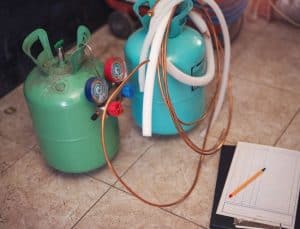A car’s air conditioning system keeps your car cabin cool when it’s working properly. Even the drop in the cooling capability can signify low freon levels. It’s suggested to solve this problem as soon as you detect it.
You are at the perfect place as you face the low freon problem in your car. Fortunately, getting the cause of low freon level in the car’s AC system isn’t difficult.
In this article, we’ll discuss freon, how it works as well as all signs of low freon in cars.
What is Freon?

AC systems on cars used freon (R-12) that composed out of CFC before 1994. But, the Montreal Protocol banned the use of CFC, because of its dangerous impact on Earth’s ozone layer. Therefore car AC systems start to use environmentally friendly R-134a freon.
Freon is a chlorine, fluorine, bromine and carbon-hydrogen mixture substance. These products widely used in car’s AC systems, become synonyms of refrigerants. It’s gaseous at room temperature and doesn’t have a specific colour or smell. This turns into a liquid state when it’s compressed by a car’s AC system.
How does a car’s Air Conditioning system work?
Your car’s air conditioning system is filled with a highly specialized gas called freon. It’s just similar to the AC system in your home. The system used to deliver cool air is called Freon. There’s no system to circulate cold air throughout your auto cabin without it.
AC systems compressor pressurizes the freon to turn this gas into a liquid. This change in pressure practically lets the system generate cool air that’s circulated throughout the car’s cabin.
Air conditioning systems are all about constant circulation of freon through the pressure. Like any mechanical system, these pressurized systems come to below over time. Sometimes, the pressure and freon levels fall too low in the AC system. As a result, the performance of your car’s AC system will go down.
Any decrease of freon in the car’s AC system may result in malfunction. Then you have to check properly to make sure that it is working properly.
However, once the A/C system drops too low, it must be recharged with pressurized freon. So, how do you know if your car is in low freon? Well, there are signs of low freon in the car. Here we’ll discuss the most common signs of low freon in the car that you look out for.
Seven Significant Signs of Low Freon in Car:

How do you notice if your car’s air conditioning is low? There are seven significant signs of low freon in your car.
- Blowing Hot Air from AC:
Once you set your car’s air conditioning system, it should blow cool air. Blowing room temperature air from your car’s AC system isn’t normal.
When your air conditioner is blowing hot air from the vents, it’s a significant symptom of low freon levels. As we discussed above, the AC system in your car performs by circulating pressurized refrigerant.
In case the amount falls too low, it ultimately affects the performance. As a result, you’ll discover that the system is blowing up with the hot air. This indicates that either the freon levels are extremely low or run out entirely.
- Loss in Cooling Capability:
This is another vital sign of low freon when there’s loss in the cooling capability of your car AC system. The amount drops too low will finally affect the performance of the system. As a result, you’ll notice that your air conditioning isn’t blowing as cool air as it was before.
AC contains a lot of refrigerants that work for cooling inside the car. It’s lower the performance of the cooling system once your freon becomes low. Are you feeling the same as your car isn’t blowing cold air anyhow? Then there’s a big possibility that you’re going up low freon in your car.
Again, when you find a rapid loss of cooling capability during driving, there’s also a chance of leak in your system. Although rapid refrigerant loss in driving occurs rarely, it is one of the common signs of low freon.
- AC Clutch Fails To Engage:
If everything’s working properly, you should hear the ‘click’ on the clutch engaging when you turn your car’s air conditioner. But, the clutch will fail to engage once the freon levels are going too low. That indicates there’s not enough refrigerant present for the compressor to pressurize.
Why is ‘click’ on clutch engagement so important? Because the clutch is worked by reading freon levels and letting the compressor to pressurize the freon.
It didn’t engage when there’s not enough freon, and you can’t hear that click. There’s your AC system isn’t able to circulate the refrigerant, as a result, the system will not work properly.
- Visible Refrigerant Leaks:
A visible refrigerant leak is another serious sign of low freon levels. Freon usually looks like a ‘thin’ greasy substance in liquid state. If any leaks happen, you will find thin greasy substance inside the cabin or underneath the car. Hopefully, it’s not difficult for drivers to discover the freon in the compressor lines of the car. Therefore you have to clean up this greasy thin substance.
When you notice it, and then you see the greasy liquid seems again at a similar spot, it’s an obvious sign of freon leakage. The leaks refrigerant will eventually cause your AC system to no longer work. You can use a Refrigerant Leak Detector to find out any visible refrigerant leaks.

If you find any visible refrigerant leaks, you should go to your nearby auto repair shop. There an ASE Certified technician examines the problem and therefore takes required steps.
- Ice on the Compressor:
Ice presence on the compressor can signify that the system has low freon levels. This is mostly because of moisture taking the place of freon. When the freon levels become low,
moisture in the system begins to occupy its place and starts to freeze.
In most cases, ice accumulation on the compressor signifies low freon levels. Why are these caused? During this time, the moisture takes the place of the freon. That will decrease the system’s cooling capacity into the car’s cabin.
- Air Conditioning Gauge Reading:
AC system pressure can be gauged by hooking up a manifold gauge to the high to low-service ports. The high side gauge (red) hose connects with a rapid release fitting to the high-side service port. Where the low-side gauge (blue) hose connects to the service port of low-side.
Static pressure on the gauges have 80-105 psi when gauge knobs open with the engine and air conditioning off. The low-side gauge read 25-35 psi with the running engine and air conditioning turned on to top. Where the high-side gauge should read 200 to 350 psi. All-around lower or near zero readings signify total refrigerant loss.
- Unclear Liquid Moving Sight:
Modern cars come with sight glass. It’s very simple to visually inspect refrigerant movement through that. You’ll see the liquid side, high-pressure line plus fluid moving.
A well-charged system will show precise and clear liquid moving through the line. Apart from that, low refrigerant levels will show bubbles or blur appearance.
Frequently Asked Questions:
- Is it dangerous to run AC with low Freon?
Answer: Your car AC system can still function at lower cooling power later it loses Freon. But, it will ultimately show up to some serious type of damage. That requires a major repair and most probably lead to the full system breakdown. Loss of freon also damages the compressor by running it while overheating.
- Is the freon a flammable substance?
Answer: Freon is a combination of chlorine, fluorine, bromine and carbon-hydrogen. These products widely used in car’s AC systems, become synonyms of refrigerants. Although, freon is no flammable substance but it’s very toxic. You should wear Safety Gloves and Safety Goggles when adding freon to your car’s AC system.
- How do I know when my car AC needs to be recharged?
Answer: When your car AC system gives hot air than cold, therefore you’ll need an AC recharge. It indicates that your AC system can’t function properly. This is because of the low level of freon or small form of leaks in the system.
What is a Recharge?
Commonly, when you take your car for an AC recharge, the mechanic will check the system pressures with gauges.
When the freon is low, he tries to find out any leaks by Refrigerant Leak Detector. Once he finds the leaks, he’ll evacuate the system and repair the leak so that he can refill it. If the system is very low or empty, refrigerant will have to be added after repairing the leak.
So, an AC recharge includes evacuating the old refrigerant and again refills it with fresh.
Conclusion:
Car’s Air Conditioning system is all about the circulation of pressurised freon. These pressurized systems come below over time like a mechanical system. Any decrease of freon levels reduces the performance of your car’s AC system. You have to detect any signs of low freon in the car. It needs to recharge with a pressurized freon once the AC system falls too low.
